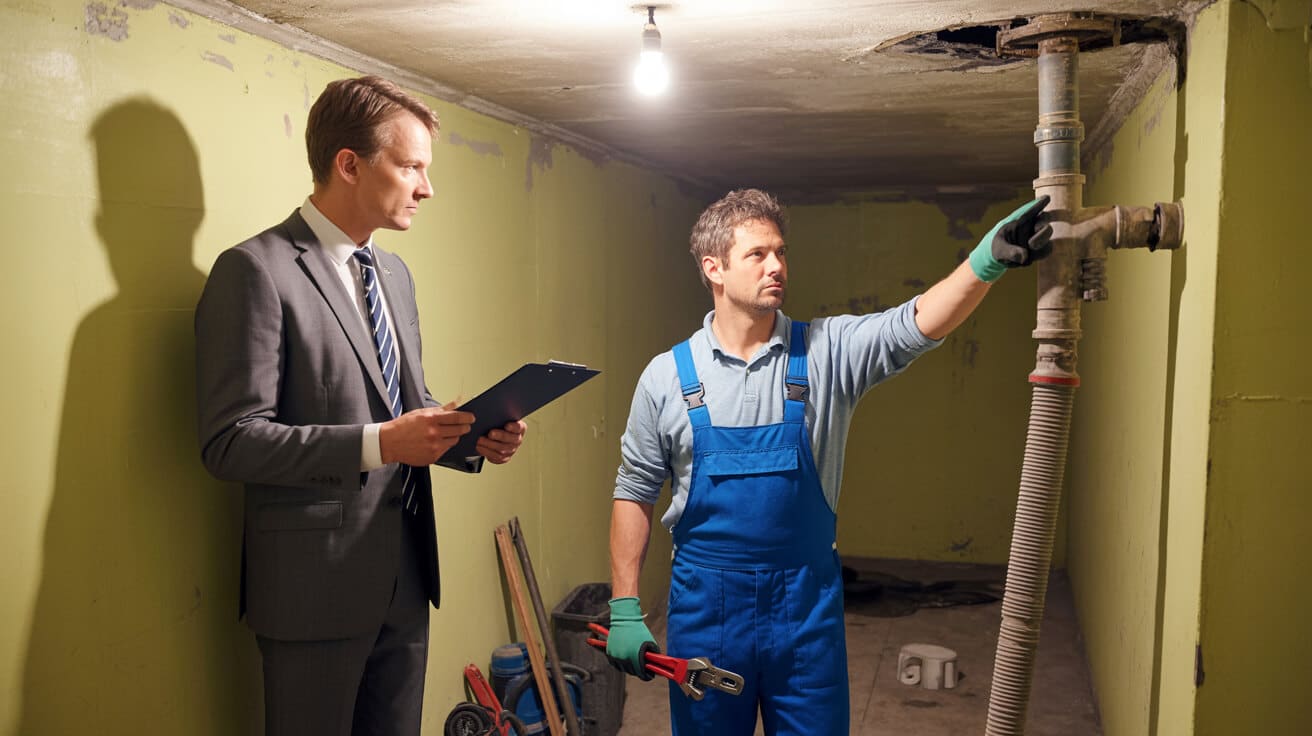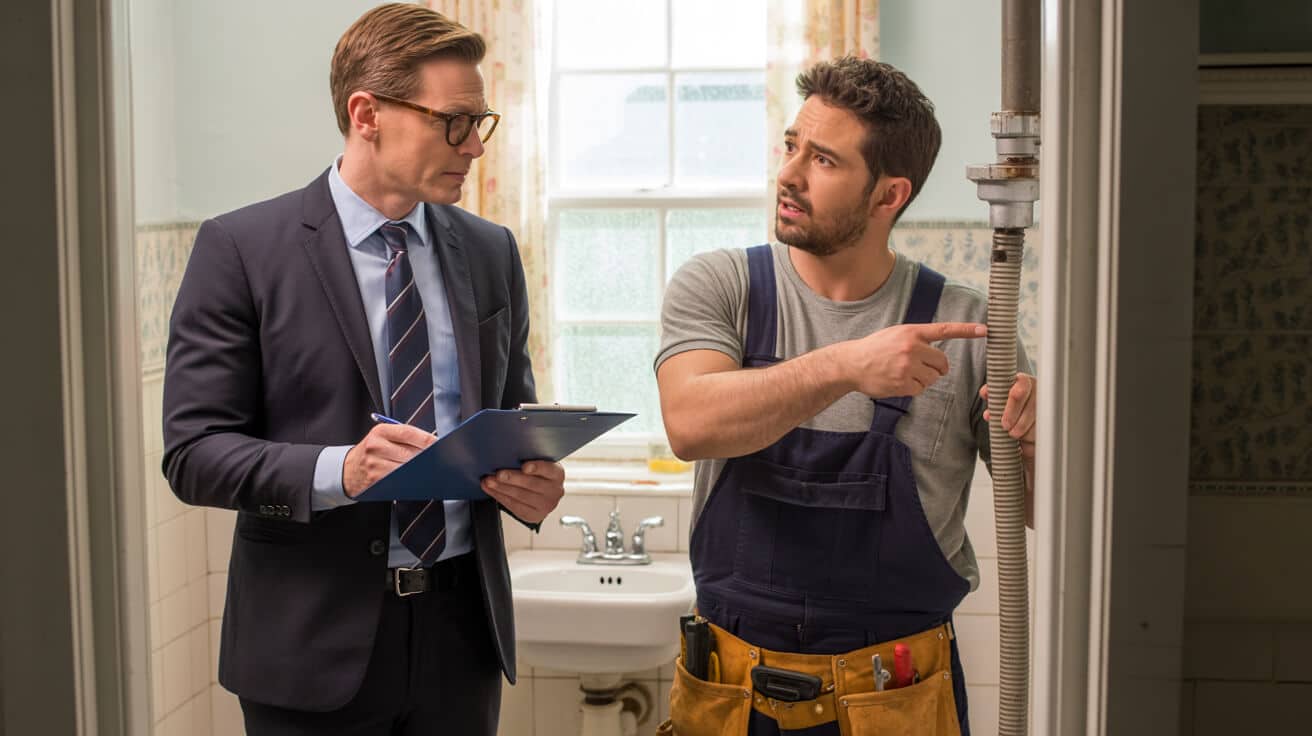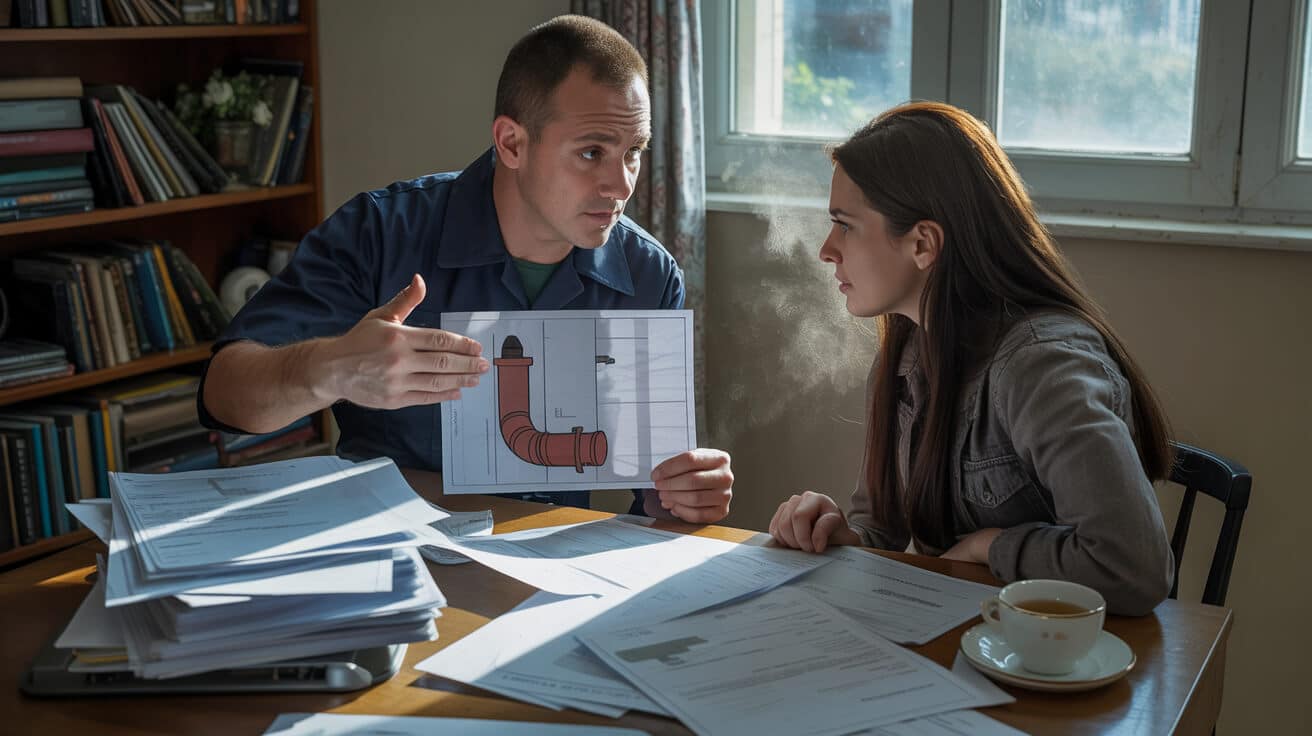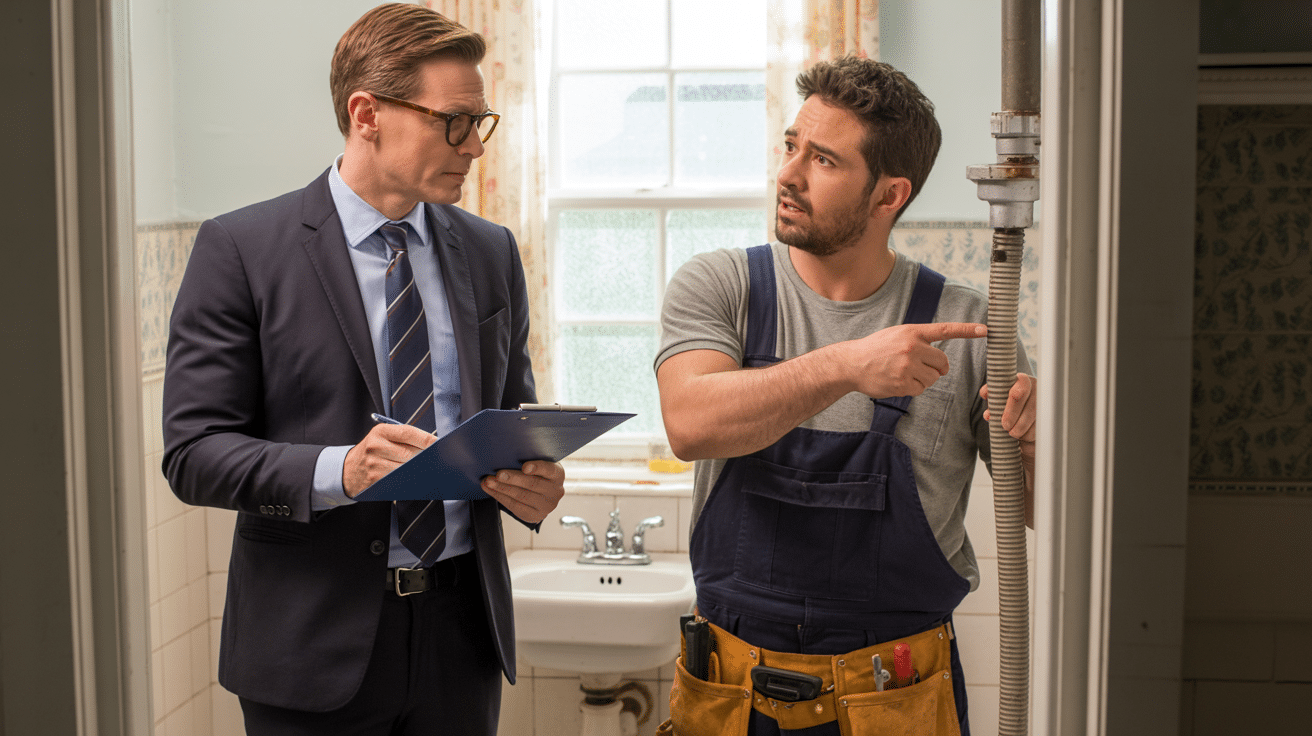 How Property Managers Should Handle Multi Tenant Plumbing Complaints
How Property Managers Should Handle Multi Tenant Plumbing Complaints

How Should Property Managers Handle Multi-Tenant Plumbing Complaints Without Sacrificing Trust or Breaking the Law?
Plumbing complaints in multi-tenant buildings strike deeper than pipes—they challenge your reputation, tenant relationships, and legal standing. Every time water stains a ceiling or a tenant’s bathroom is out of action, you’re measured not only on speed but on transparency, compliance, and your ability to prove exactly how you responded. Ignoring small issues, delaying communication, or failing to document can lead to insurance headaches, compensation claims, and an erosion of trust that lingers far beyond the cleanup.
Every complaint you solve (or fumble) is a public test of your reliability.
The highest-performing property managers don’t just leap to patch the leak; they treat every incident as a compliance event. Clear reporting, audit-ready logs, and visible empathy turn stress into an opportunity for loyalty and long-term value. Your clients—and the law—expect you to get it right the first time, every time, and to leave behind not just a dry floor, but a paper trail that closes every loop.
How Can You Guarantee Tenants Report Plumbing Emergencies Instantly—and Accurately?

Few risks compound faster than an unnoticed leak or a silent backflow in a block of flats. Minutes become hours; minor damage becomes major—and missed communications reveal management blind spots no insurer or tenant will overlook. But tenants aren’t always sure when to speak up, especially in shared buildings or if English isn’t their first language. The only answer is to build a process that makes reporting plumbing troubles as friction-free and universal as the water supply itself.
Creating a Reporting Culture Tenants Trust—And Use
The best property managers break the pattern of “late report, delayed fix” by:
- Posting multilingual, graphic-rich guides: in communal areas—simple icons and steps anyone can follow, even in a panic
- Embedding clear plumbing emergency instructions: into digital onboarding packs, with highlighted emergency contacts, SMS/WhatsApp numbers, and even QR codes to register issues instantly
- Guaranteeing 24/7 reporting: —not just voicemail or office-hour call-backs, but a system where tenants can text, call, or use an app to create a support ticket at any hour, every day
Systems that rely on memory or mood are always a step behind silent leaks.
Reducing Friction with Technology and a Human Touch
Many tenants hesitate to report because they fear blame, complexity, or language barriers. Remove these walls by:
- Letting people upload photos or send voice notes, not just fill in forms
- Ensuring rapid access to a real, on-call manager or contractor—no phone tag
- Adopting “no blame” reporting policies, focusing on fast action and tenant safety, not the source of the issue
The result: emergencies get logged before they escalate, property disasters shrink, and tenants see management as partners, not gatekeepers.
Why Is Logging and Acknowledgement Non-Negotiable in Multi-Tenant Block Management?

If an emergency has no timestamp, status, or owner, no one’s responsible—and risk accumulates in silence. Too many managers treat complaint logs as afterthoughts, but in a regulatory landscape built on evidence, digital recordkeeping is the difference between running a respected block and firefighting after the fact.
The Rule: Every Complaint Gets Logged and Tracked
Modern property professionals insist that:
- All issues, large or small, are filed in a central, secure platform: on the same day—paper logs and sticky notes don’t cut it
- Every filing automatically triggers a timestamp, case number, and receipt to the reporting tenant: —no more “I never heard back”
- Case status (received, in progress, resolved, escalated) is visible to managers, tenants, and reporting landlords in real-time:
This isn’t overkill—it’s legal hygiene. The paper trail doesn’t just shield you in disputes or insurance claims, but demonstrates proactive, regulated management to auditors, insurers, and owner clients.
If you can’t prove what happened and when, not much else matters when scrutiny hits.
Constructing the Timeline That Protects Everyone
Beyond simply logging the initial complaint, protect your stakeholders (and your management fee) by:
- Storing photo evidence, written statements, and communication snapshots for each case
- Capturing the exact attendance and sign-off time of every specialist, with part codes and repair notes attached
- Copying final job summaries and compliance certs to both tenant and landlord for joined-up communication
Smart platforms allow for customizable handover documents and reminders, meaning complaints are tracked, responded to, and closed off with proof—removing the “did you fix it?” tension from your inbox.
How Does Evidence Collection Transform Liability and Resolution Speed?

Too often, property managers rely on memory, hearsay, and “he said, she said” to navigate disputes. That’s a gamble, especially in multi-tenant properties where leaks, overflows, or slow repairs affect multiple parties and potential insurers. The gold standard is a system that treats every incident like a file in a courtroom—photo timestamps, engineer credentials, and chain-of-custody for every intervention.
Making Tenants Allies in the Evidence Trail
Encourage tenants to support their complaint with:
- Photos, videos, or voice recordings that clarify what’s wrong: —including isolation points, water spread, and possessions at risk
- Details of any interventions taken (like turning off a stopcock): to show active risk mitigation
Pre-set forms, app interfaces, and guided SMS follow-ups (“Send us a picture of your stopcock, or check underneath the sink for dripping water”) help standardise evidence and reduce ambiguity when claims or blame move between flats.
The more evidence you collect upfront, the fewer back-and-forths you’ll face when the pressure’s on.
One Secure Source for Every Event—From Emergency to Resolution
Store your records in a central, GDPR-compliant platform that:
- Links media, communication, and engineer logs to the same case number
- Maintains access logs (so only authorised parties see sensitive data)
- Exports fast, shareable reports for tenants, owners, and insurers—reducing time spent rehashing old repairs or hunting for paperwork
By turning proof-building into a habit, you reduce liability, speed up insurance payouts, and prove due diligence in case a regulator or ombudsman comes knocking.
What Preventative Measures Reduce Damage Before Repairs Even Start?

Swift repairs are only half the storey—much of the loss, disruption, and legal fallout from plumbing incidents can be avoided in the first minutes after a fault is detected. That’s why the top property managers arm tenants with practical, stepwise containment skills (without expecting heroics or risk).
Empowering Tenants Without Putting Them in Danger
Don’t leave your tenants or staff guessing. Issue:
- Punchy, picture-led shutoff instructions (in multiple languages if needed) fixed at every key location: risers, metres, plant rooms
- “Never touch” guidance about anything electrical, gas-related, or hard to reach
- Advice to contain water (move belongings, avoid soaked areas) but not to attempt DIY repairs or valve turns they haven’t been shown
Follow-up SMS templates sent upon report (“Here’s what you can safely do while help is on the way”) buy precious minutes, limiting spread and secondary losses—especially if you’re working across large, multi-tenant sites.
Onsite Prompts and Regular Checks: The Prevention Dividend
No workflow is future-proof unless it’s visually reinforced. Ensure:
- Engineers place clear, durable labels on every stopcock, PRV, and riser they touch:
- Tenant briefings at move-in and annual reviews to keep everyone up to speed:
- Site managers audit signage and instructions (ideally every quarter):
These micro-steps drive home clarity and control, giving you and your contractors vital leverage when the next crisis tests your systems.
The next emergency always comes when least expected—are your labels and instructions ready?
What Role Do Qualifications and Diagnostics Play in Fixing Multi-Tenant Plumbing Faults?

Regulators, insurers, and the Housing Ombudsman pay close attention to the competence and documentation of every engineer sent to site—especially in complex environments like blocks of flats or commercial buildings with shared supplies.
Only Qualified, Certified, and Proven Engineers Get You Out of (and Keep You Free From) Trouble
Property teams must:
- Dispatch only WaterSafe-registered, WRAS-approved engineers for potable water systems: ; unvented cylinder work must require visible G3 certification and manufacturer-aligned experience
- Check all contractors for site-ready credentials (CSCS cards, PPE records, insurance proof): before every visit
- Add every qualification and log every attendance in the property file—part of your annual compliance audit readiness:
If you can’t provide a name, registration, or benchmark record for a fix, you’re exposed to dispute regardless of how well the repair was done.
In regulated plumbing, qualified isn’t a preference—it’s a legal and reputation requirement.
Precision Beats Guesswork: Upgrade Your Diagnostics
Low-cost fixes based on guesswork are a trap. Invest in engineers and contractors who can:
- Deploy thermal imaging, pressure-drop tests, and trace-dye techniques: for hidden leaks and stack problems
- Use endoscopic cameras: for inaccessible pipework, minimising damage and errors
- Log every step—from photo evidence to final pressure readings—to remove ambiguity from the repair:
Every correctly diagnosed, documented, and signed-off repair builds value for your block and shields you from penalties or insurance claim fall-outs.
How Do You Build Compliance, Trust, and Future-Proof Your Portfolio with Every Repair?

Every plumbing fix is more than a repair: it’s an audit event, a trust test, and a chance to reinforce the compliance backbone of your entire property portfolio. The standard is evidence, not anecdotes.
At Every Step: Compliance, Audit, and Transparent Communication
Top managers demand that their engineers:
- Provide WRAS approval or labelled photos for all installed parts:
- Complete the Benchmark logbook and issue G3 documentation for any cylinder or system intervention:
- Log signed, time-stamped service reports with before-and-after photos:
No repair is closed until the engineer walks the site with the tenant or manager, demonstrates the fix, and notes any limitations or instructions. This handover not only cements the event in your log but increases future incident prevention.
Tenants and owners remember the manager who took time to close the loop—and the property that didn’t suffer repeat faults.
Audit-Proofing and Data Retention: Your Defence in Claims
For recurring value, your platform needs:
- Visual proof of every job—system readings, part alignment, and safety confirmations:
- Engineer and contractor credential records attached to each file:
- Clear aftercare and maintenance scheduling for recurring issues:
These details guarantee you win arguments over “when, who, how, and what” if insurance, regulators, or owners dispute a repair.
Consistent Validation—Costly, But Invaluable
Never sign off a fix without:
- Testing and documenting system pressure and flow
- Checking for residual leaks at joints, traps, or isolation points
- Resetting timers and thermostatic devices to safe occupant defaults
Regular audit of these steps scales trust with tenants, owners, and your wider property network.
How Can Each Plumbing Incident Turn Into a Reputation and Relationship Win?

Plumbing faults reveal more about a property manager’s competence than any lease negotiation or fee structure. The difference between a manager tenants recommend (or landlords retain) and one they don’t is often shown in the aftermath of a problem. Are you invisible after the fix, or do you take charge and communicate like a leader?
Communication as a Service—Proactive, Not Defensive
After each incident, your system should ensure that every tenant, owner, and agent receives:
- A written incident summary covering what went wrong, what you did, who did it, and what to watch for
- Visual before-and-after proof, with engineer credentials and repair dates
- Personal follow-up (not forgettable mass emails), tuned to the resident’s needs
Management is felt in the moments after the chaos, not just in the fix itself.
Ongoing Education and Empowerment
Funnel complaints into prevention by sending targeted reminders:
- How to spot slow leaks, system noises, or pressure drops before disaster
- Signs of failing isolation valves, faulty appliances, or overflow risks
- Instructions on how and when to seek help—even for small changes
When tenants and landlords feel heard and equipped, disputes drop and referrals rise. Proactive managers become the standard for sector excellence.
Data: Not Just for Audit, But for Growth
Store every record, photo, and follow-up in a cloud-based, exportable system:
- Enables rapid insurance and compliance documentation
- Supports new team training or handover between onsite managers
- Provides a living archive to reinforce lessons and improve future workflow
Routine scheduling of health checks, site audits, and “what to watch for” comms cements your reputation as a protector—not just a fixer.
Why Do Top Property Managers Choose Plumbers 4U To Safeguard Their Portfolios?
Your challenge isn’t just fixing today’s issues—it’s having an auditable, reputational shield around your portfolio. Plumbers 4U is designed to fit the rigorous standards of UK block management, offering not just fast fixes but a true, compliance-driven partnership whose value is visible at every audit and lease review.
Why Our Model Endures When Others Falter
- 24/7 National Coverage: Houses, flats, commercial, and public sites—no “areas not covered,” no “waiting until Monday”
- Every engineer is WaterSafe-registered, WRAS- and G3-certified, and CSCS carded for multi-occupancy or shared site access:
- Every action is logged, from the initial call to the final pressure test, and made instantly shareable to your CRM or audit files:
Documentation isn’t an afterthought—it’s as standard as the spanner.
Audit-Ready Standards, Zero Hassle
- Over 90% of block and landlord claims handled by Plumbers 4U pass first-stage insurer compliance due to complete photographic and credentials reports ([Plumbers 4U Internal Data, 2024])
- Our engineers perform and log every system test—pressure, fitment, seal, and timer—before sign-off, with audit-ready documentation at hand, not on your to-do list
- Flat pricing, prompt service, and digital records ensure your tenants, owners, and board can see not just the repair—but the care taken to document it
We Value What You Value: Safety, Proof, and Calm
Your sites are left clean, quiet, and complaint-proofed. Tenant and landlord instructions are delivered in plain English, with follow-up routines set before we leave site, and grants, tenders, and compliance certificates included for your next review.
Choose the partner who works as hard on your peace of mind as on your plumbing.
Secure Your Multi-Tenant Properties with Plumbers 4U
You can’t prevent every leak, but you can turn every crisis into a management win. Property managers who standardise on transparent, compliant, and well-documented plumbing workflows—supported by partners like Plumbers 4U—reduce sleepless nights, regulatory exposure, and tenant churn. Bring us on board and get the systems, expertise, and documentation you need to make plumbing complaints a source of trust rather than tension. Protect your buildings, your name, and your business—for today’s emergencies, tomorrow’s audits, and everything in between.
Frequently Asked Questions
How does a plumbing emergency in a multi-tenant property truly challenge property management routines?
Every multi-tenant plumbing emergency exposes the strengths—or weak points—of your entire management system in real time. What differentiates a single-flat fix from a cross-floor incident is not just the complexity, but the reputational, legal, and practical scrutiny: with multiple residents involved, delays escalate, risks compound, and your ability to coordinate, communicate, and prove actions is judged by both tenants and insurers. When water threatens several homes, the standard playbook of “dispatch and hope” fails; you need integrated triage, parallel updates, and bulletproof records from minute one.
When response is measured in minutes, not hours, your team’s reliability becomes part of the asset value—not a wild card your clients worry over.
What distinguishes multi-unit emergencies from routine calls?
- Immediate, system-wide assessment: rapid checks in adjacent units, vertical risers, and shared infrastructure
- Fast escalation protocols when electrics or safety are at risk
- Documentation tied to specific case numbers and time-stamped actions for every tenant
- Updates deployed through multiple channels—phone, text, digital—so no one is left in the dark
- Certified engineers (WRAS, WaterSafe, G3) only, with proof on file before work begins
- Visible evidence trails for every action, ready for audits or claims
Successful handling is no longer about simply fixing a leak; it’s about managing complexity in full view, protecting all parties, and showing insurers you run a tight, documented ship—every time. This is the new benchmark for excellence, and why modern landlords and block managers turn to providers like Plumbers 4U who offer block-specific protocols beyond ordinary plumbing.
Why is next-generation evidence gathering now the standard in block plumbing issues?
Insurers, local authorities, and even tenants expect far more than just a receipt and a blurry photo. Today’s high-stakes plumbing events require layered, time-synced evidence: visuals tie every unit and step together, communications are logged in real time, and engineer credentials are cross-referenced with repair zones. This multi-format record is now the difference between fast claims payouts (or avoided legal trouble) and being stuck in administrative quicksand.
Tenants should be empowered to send multi-angle photos and brief video clips immediately. For every intervention, timestamped documentation should show which valves were closed, which temporary repairs were made, and—critically—that only qualified personnel were present. Engineer IDs (with WRAS/WaterSafe/G3 icons in the snap) should be digitally stored alongside pre- and post-repair images, allowing future auditors or insurers instant case-by-case traceability.
A complete audit trail does more than protect you—it earns upstream trust, accelerates insurance response, and prevents small oversights from becoming costly mistakes.
What’s expected in block-grade incident documentation?
- Affected-unit photos and video: before/after plus isolation/containment steps
- Engineer badge close-ups matched to job start time
- Complete message logs with tenants and insurers (phone/SMS/email/portal)
- Chronological mapping of actions to specific rooms and system locations
- Secure, cloud-based archiving for instant recall and compliance reviews
Confidence with major incidents now depends on integrated, multi-format records—making your processes visible, defensible, and always one step ahead of dispute or claim.
What proven steps differentiate a local plumbing glitch from a block-wide or systemic fault?
The first minutes after a water complaint are when costly misdiagnosis or missed hidden threats most often occur. Reactive repairs—focusing only on the reporting flat—risk ignoring silent spreads in pipe risers, shared drains, or cross-floor systems. The winning approach: treat every call as a potential building-wide event, running instant upstream and downstream checks to expose the real scope.
Surveys begin by asking the initial complainant if the neighbours above, below, or beside have noticed any issue (low pressure, loss of heating, new damp). Request every flat in a possible zone of impact to try isolating their own supply at the local stopcock; if symptoms persist, suspect a shared supply or riser problem. Check your property history—recurring issues in the same vertical stack are nearly always systemic. Deploy digital tools: a quick pulse-check of central sensor networks or smart metres speeds up “pattern-detection” beyond what a manual log can offer.
The leap from one report to several is when a minor repair pivots to a crisis. Make this lens-shift routine, and you lock down risk before it leaks into claims or reputational damage.
Systemic vs. isolated: the decision chain
- Multi-flat survey and symptom mapping within 30 minutes
- Valve isolations to test if problem is flat-specific or network-based
- Operations team reviews digital and historical maintenance logs for repeat issues
- Engineers run moisture or temperature assessments in risers, intake points, and shared stacks
- All findings logged in a system for immediate and future-proof pattern recognition
Treating every “minor” event as a diagnostic opportunity not only prevents escalation, it builds lasting credibility for your management reputation.
Where do compliance and credentialing gaps expose property managers to risk on block-scale plumbing jobs?
Every shared water, heating, or drainage repair in a block, HMO, or managed property now falls squarely under a suite of regulations (WRAS, Water Regs 1999, G3, WaterSafe), all of which can void insurance or trigger fines if breached. Even if a job “appears fixed,” if the paperwork or engineer’s credentials aren’t bulletproof, you’re exposing your business to claims rejections and compliance penalties down the road.
Modern best practice doesn’t just demand that you hire certified plumbers—it requires you to save visible proof for every visit, link credentials to each case, and proactively trigger compliance reviews on any significant repair to shared systems. Local authorities and insurers both run spot checks; gaps, missing paperwork, or untraceable contractors now trip penalties or invalidate risk cover, especially in the wake of major repairs.
Being hands-on is not a defence; being compliance-driven is. Tenants, regulators, and insurers all check your records—make credentialing and archive access central, not an afterthought.
Regulatory musts for every block repair
- Engineer certification (WRAS/WaterSafe/G3 badge) validated before attending site
- Credentials archived with each job, not just a central list, for minimum 6 years
- Engineer work photographed before, during, and after repair—showing both process and result
- Repairs on shared systems trigger entries in compliance and insurance review calendars
- Refuse any “unbadged” or non-transparent contractors: your audit trail is your only shield if something goes wrong
Only property managers able to demonstrate this compliance “defence wall” are trusted by top insurers and secure licencing in changing regulatory environments.
How can property managers improve communication to maintain trust and reduce liability during multi-unit plumbing events?
Consistent, multi-channel updates transform a stressful disruption into an exercise in transparency—dramatically cutting both complaints and legal exposure. The cadence of response (who gets told what, when, and how) often matters more to tenants and stakeholders than technical speed alone. Early, clear, and recurring communication both reassures residents and builds a narrative of professional control—essential for satisfying diverse interests from leaseholders to regulators.
For each event, acknowledge receipt rapidly (under 10 minutes) and give all affected parties an ETA for intervention, plus safety steps if hazards are present (turn off electricity, avoidance of wet zones). Update at every stage change—arrival on site, repair progress, estimate to fix, water shutdown, and restoration window. Closing each case with a summary (in writing, with visuals) completes the loop and captures trust for future referrals or renewal decisions.
In moments of confusion, clear updates prevent panic. A well-informed tenant is less likely to escalate, complain, or seek outside remedies.
Block plumbing event communications plan
- Complaint acknowledged to reporting party under 10 minutes
- Group notice for shared-system risk, no later than 30 minutes in
- ETA, status, safety, and resolution updates each time the situation develops
- Post-repair wrap: plain-language report with images and prevention tips for recurrence
- Aftercare follow-up (annual or after major event) with maintenance guidance and feedback request
When communication is documented as tightly as repairs, you insulate both asset value and brand reputation.
What systems and habits prevent repeat emergencies and enhance long-term stability in block plumbing management?
Turning short-term fixes into long-term reliability is the mark of a property manager invested in genuine asset health. This means deploying proactive aftercare and digital process improvement, not just responding to the symptom in front of you. Recurrent complaints often trace back to hidden infrastructure faults, missed inspection cycles, or unclear tenant instructions.
Imprint prevention in every workflow: build onboarding guides so residents understand how daily choices impact plumbing, schedule regular audits of block infrastructure and photo-log every round, and issue early-warning digital bulletins when any repair hints at a recurring issue. Archive every incident and resolution for instant recall, allowing evidence-driven strategy instead of gut-feel fixes. Critically, demand every contractor offers export-friendly records—you want to own and keep your history, for audit, resale, or asset review.
Reliability isn’t just about fewer breakdowns—it’s about earning repeat trust from stakeholders, auditors, and future buyers.
Prevention, stability, and audit elevation
- Move-in cards and annual reminders to educate on “what not to flush/pour,” reporting, and safe response steps
- Scheduled multi-point block audits with digital archive and photographic evidence
- After every incident, provide tenants with digital care packs and troubleshooting tips
- Central case-archive with keyword search for instant insurance or regulatory requests
- Hire only firms (like Plumbers 4U) that deliver digital, portfolio-ready records for every event—no chasers needed
Property management rises to excellence when every fix becomes a stepping stone to a stronger, more resilient building—and a more valuable, stress-free letting or ownership experience.
For portfolio-grade protection, reliable compliance, and tenants who remember your steady hand instead of their last crisis, partner with Plumbers 4U. Trusted engineers, transparent records, and results that prove themselves in the moments that matter most.
